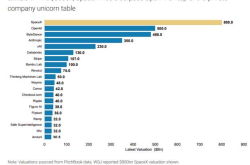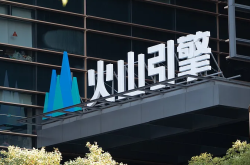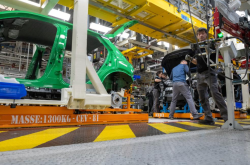Synchronized Market Surge: A+H Shares Continue to Heat Up with 'Inverted' Phenomenon
![]() 07/08 2025
07/08 2025
![]() 549
549

On July 8, A-shares and Hong Kong stocks synchronized in a market surge, with the Shanghai Composite Index reaching an intraday high of 3,497.22 points, just shy of the 3,500-point mark. The Hang Seng Index rose 0.78% to 24,073.04 points by midday, hitting a three-month high. Over 3,500 stocks rose across Shanghai, Shenzhen, and Beijing exchanges, with the ChiNext Index surging 2.26%. Technology stocks and the new energy sector led gains in Hong Kong stocks, significantly increasing market trading activity.
A-share Market: Shanghai Composite Index Approaches 3,500 Points
As of press time, the Shanghai Composite Index rose 0.58% to 3,477.44 points, the Shenzhen Component Index increased 1.27%, the ChiNext Index gained 2.26%, and the STAR 50 Index advanced 1.31%. The half-day trading volume of both markets reached RMB 885.331 billion, up 12% from the previous trading day, indicating strong fund inflow intentions.
The electric power equipment (photovoltaics), electronics (computing power hardware), and communication (CPO) sectors led the gains. The photovoltaic industry chain was boosted by the Ministry of Industry and Information Technology's 'anti-involution' policy, enhancing corporate confidence. The accelerated deployment of NVIDIA's Blackwell GB200 chip drove gains in computing power hardware stocks, such as Foxconn.
The rare earth permanent magnet concept surged, with Jiuling Technology and Zhongke Magnetics hitting daily limits. The Ministry of Commerce's tightening control over rare earth exports, combined with expectations of mass production of humanoid robots, pushed the sector's medium-term trend upwards.
According to Eastmoney Choice data, the net profit of the securities industry in the first quarter increased by 83.48% year-on-year. Recent policies have frequently brought benefits, allowing enterprises in the Guangdong-Hong Kong-Macao Greater Bay Area to return to the Shenzhen Stock Exchange for listing, further stimulating trading activity.
The issuance of public funds accelerated, with 39 new funds hitting the market this week. The number of private fund filings hit a new high for the year, providing incremental funds to the market. Institutions generally believe that current A-share valuations are at a historical low, and the market has upward potential under the expectations of policy support and earnings recovery.
Hong Kong Stock Market: Hang Seng Index Approaches 25,000 Points
The Hang Seng Index rose 0.78% to 24,073.04 points by midday, the Hang Seng TECH Index gained 1.29%, and the Hang Seng China Enterprises Index increased 0.84%, with a half-day trading volume of HKD 117.194 billion. Southbound funds continued to flow in, with cumulative net purchases exceeding HKD 730 billion in the first half of the year, a record high for the same period.
Technology stocks emerged as the core engine, with technology giants such as Alibaba, Tencent, and Meituan leading the gains. The surge in demand for AI technology commercialization and cloud services drove earnings beyond expectations. Taking Alibaba Cloud as an example, its revenue in the third quarter of 2024 increased by 13% year-on-year, with AI-related revenue achieving triple-digit growth.
A new consumption concept emerged, with the 'new consumption trio' of Lao Pu Gold, Pop Mart, and Mixue Group performing impressively. Lao Pu Gold's share price surged 321.53% in the first half of the year, and Pop Mart's LABUBU series products sparked a global buying frenzy.
Policy dividends continued to be released, with the Hong Kong Securities and Futures Commission promoting the inclusion of RMB stock trading counters into the Stock Connect program, expanding the scope of institutions participating in Southbound Trading, and optimizing the offshore RMB bond repo business, attracting global fund allocation.
Star Stock Performance: Gangya Holdings soared 15.4 times due to Bitcoin investments and a general offer; Yuejiang Robotics released a 'dexterous manipulation + straight-knee walking' humanoid robot, doubling its share price; GL Pharma's weight loss drug clinical trial was approved, with a single-day gain exceeding 10%.
78 A-share Listed Companies Disclose 'Positive' Earnings Forecasts
As the window period for semi-annual earnings forecasts enters its peak, the A-share market welcomes its first batch of 'report cards'. As of 21:00 on July 7, Wind data showed that 78 listed companies had released their earnings forecasts for the first half of 2025, of which 54 companies had 'positive' earnings forecasts (including pre-increase, slight increase, and turnaround), accounting for about 70%. The upper limit of net profit attributable to shareholders of ordinary shareholders of 25 companies increased by more than 100%, and companies such as Hanyu Pharmaceutical achieved a turnaround, significantly boosting market confidence.
Among the companies with 'positive' earnings forecasts, the technology sector stood out. In the semiconductor field, the net profit attributable to shareholders of ordinary shareholders of companies such as Tai Ling Micro and Rockchip increased by more than 100% year-on-year. Rockchip announced that the explosive growth of the AIoT market drove demand for flagship and new products, and revenue across product lines increased significantly year-on-year. As the leading AI server company, Foxconn Industrial Internet expected its net profit attributable to shareholders of ordinary shareholders to reach between RMB 11.958 billion and RMB 12.158 billion in the first half of the year, an increase of 36.84% to 39.12% year-on-year. Its cloud computing business achieved record-high revenue growth in the second quarter, and its communication and mobile network equipment business also maintained steady growth.
The basic chemical industry also had various highlights. Lier Chemical benefited from increases in both product prices and volumes, as well as cost reduction and efficiency enhancement, expecting its net profit attributable to shareholders of ordinary shareholders to increase by 185.24% to 196.00% year-on-year. Nutraceuticals sales in the Newhecheng nutrition sector grew strongly, with expected net profit increasing by 50% to 70%. In addition, Sino Biopharmaceutical became the 'growth benchmark' in the medical and biological sector, with its net profit expected to increase by 253.54% to 332.10% due to the explosion of its peptide API business.
Driven by the 'anti-involution' policy and improvements in industry supply and demand patterns, the performance of pro-cyclical sectors significantly rebounded. In the marine power field, China Shipbuilding Industry expected its net profit attributable to shareholders of ordinary shareholders to range from RMB 800 million to RMB 1.15 billion in the first half of the year, an increase of 68.28% to 141.9%. The sales scale of the diesel engine sector expanded with the growth of the shipping industry. In the power sector, after the announcement of Huayin Electric Power's earnings pre-increase, its share price hit the daily limit consecutively, driving the overall strength of the sector. The increase in demand during the peak summer season and the acceleration of the construction of a unified national power market became the core catalysts.
The automotive industry also presented structural opportunities. JinGu Auto Parts expected its net profit attributable to shareholders of ordinary shareholders to increase by 44.06% to 116.08% year-on-year, and Taotao Auto increased by 70.34% to 97.81% year-on-year. Enhanced brand influence and improved sales channels drove significant earnings growth. In addition, the photovoltaic glass industry optimized supply and demand through a 30% production reduction, and domestic production in July was expected to fall to around 45GW, improving industry profitability expectations.
The performance of the pharmaceutical sector was significantly differentiated, with innovative drugs and overseas business becoming the main engines of growth. Nuotai Bio's sales of peptide APIs increased, and its net profit attributable to shareholders of ordinary shareholders was expected to increase by 32.06% to 45.27% year-on-year. Hanyu Pharmaceutical achieved a turnaround by obtaining FDA approval for its liraglutide injection and increasing exports of APIs. Institutional research showed that innovative drug companies broadened payment channels through adjustments to the commercial insurance catalog, further opening up market space.
After the earnings forecasts were disclosed, the share prices of relevant stocks performed actively. Companies such as Brother Technology and Huayin Electric Power announced daily limits the next day, indicating funds' pursuit of stocks with certain earnings. Brokerage analysts pointed out that the current market exhibits the characteristics of 'weights building the stage, growth building momentum.' After the large financial sector completed the index breakthrough, the technology and pro-cyclical sectors are expected to take over and form a sustained upward momentum.
The intensive disclosure of A-share semi-annual earnings forecasts not only verified the resilience of economic recovery but also laid a structural foundation for the market in the second half of the year. With the continuous release of policy dividends and the improvement of corporate earnings, the market is expected to continue its upward trend amidst volatility, but investors should be vigilant about challenges posed by external risks and industry differentiation.
Hong Kong Stocks Rank First Globally in IPO Financing in the First Half of the Year
Amid increasing volatility in global capital markets, Hong Kong stocks stood out with strong IPO financing performance. According to Chen Maobo, the Financial Secretary of the Hong Kong SAR Government, disclosed on July 6, the IPO fundraising amount of Hong Kong stocks in the first half of 2025 exceeded HKD 107 billion, an increase of about 22% compared to the whole of last year, temporarily ranking first globally.
The explosion of the Hong Kong IPO market in the first half of the year benefited from the concentrated listing of multiple ultra-large A+H shares. Data showed that among the 42 IPOs, 4 A+H shares and 1 H share contributed nearly three-quarters of the total fundraising amount. Among them, CATL led the world with a fundraising amount of HKD 41 billion, followed by mainland leading enterprises such as Haitian Flavoring (HKD 10.1 billion) and Hengrui Medicine (HKD 9.9 billion), highlighting the strong appeal of Hong Kong stocks to industry leaders.
Deloitte China's Capital Markets Services Group pointed out that the fervor for A+H shares stemmed from the narrowing valuation gap between the two places. Some popular stocks such as CATL even exhibited an 'inverted' phenomenon where the H-share price was higher than the A-share price, reflecting international investors' long-term confidence in high-quality mainland assets. In addition, the scarcity of A-share leading enterprises in the Hong Kong stock market and investors' expectations of their potential inclusion in the Hang Seng Index further pushed up valuations.
The recovery of the Hong Kong IPO market was inseparable from policy support and institutional reforms. The 2025 Government Work Report clearly stated 'supporting Hong Kong in consolidating and enhancing its status as an international financial center,' and regulatory authorities such as the People's Bank of China subsequently introduced a package of financial policies, including optimizing the new listing application approval process and relaxing listing standards for unprofitable technology enterprises, injecting a strong boost into the market.
The listing system reforms continuously advanced by the Hong Kong Stock Exchange also bore fruit. In the first half of the year, the number of listing applications received and processed by the Stock Exchange of Hong Kong increased significantly, with 170 active applications on the Main Board, mainly distributed across TMT (40%) and consumer (21%) industries. Notably, two overseas enterprises (from Singapore and Indonesia) successfully listed on the Main Board of Hong Kong stocks, raising HKD 3.5 billion, demonstrating Hong Kong's strengthening role as a 'super connector.'
From an industry perspective, new economy enterprises became the main force of Hong Kong IPOs. In the first half of the year, 16 new economy IPOs raised HKD 60.9 billion, accounting for 60% of the total market fundraising amount. Among them, the medical and pharmaceutical industries dominated in terms of the number of new economy IPOs, while the manufacturing industry led in fundraising amount due to ultra-large listings such as CATL.
The enthusiasm of investors was evident from the subscription situation of new shares. In the first half of the year, 97% of Hong Kong IPOs were oversubscribed, with 76% of them being oversubscribed by more than 20 times. Consumer goods enterprise Brucy recorded a record 6,000 times oversubscription, followed by Mixue Bingcheng-H shares (5,258 times) and Hu Shang Yi Yi (3,617 times), reflecting international capital's continued optimism about Chinese consumer brands.
In contrast to Hong Kong stocks' strong performance, IPO financing amounts in other major global markets generally declined. The London Stock Exchange's IPO financing amount in the first half of the year fell to GBP 160 million, the lowest record in 30 years. Commodity giant Glencore-backed metal investment company Cobalt Holdings and fast-moving consumer goods platform Shein and other enterprises canceled their listing plans in London and switched to Hong Kong.
Although the US market remained active, with 156 companies listed in the first half of the year, the fundraising amount still lagged behind Hong Kong stocks. Nasdaq and the New York Stock Exchange ranked second and third globally with fundraising amounts of HKD 71.3 billion and HKD 59 billion, respectively, far below Hong Kong stocks' HKD 107 billion.
Looking ahead to the second half of the year, the Hong Kong IPO market is expected to continue its strong performance. Deloitte China predicts that the Hong Kong new share market could see 80 new listings and raise HKD 200 billion throughout the year. Among them, A+H shares, technology, media, and telecommunications (TMT), and the consumer industry will be the main growth points.
Institutions generally concur that the key factors drawing companies to list in Hong Kong are the valuation advantage and enhanced liquidity of Hong Kong stocks. As of July 1, the trailing twelve-month (TTM) P/E ratio of the Hang Seng Index stood at 10.68, accompanied by a dividend yield of 3.93%. Meanwhile, the TTM P/E ratio of the Hang Seng TECH Index was 20.10, marking a historically low point. Kong Rong, deputy head of the TMT team at TF Securities Research, emphasized that the continued rise in foreign capital investment in the information technology sector underscores international capital's acknowledgment of the long-term value of Hong Kong stocks.
During the first half of 2025, the Hong Kong IPO market emerged as a global leader, fueled by a tripartite force of 'mega new listings, policy dividends, and technology and consumption dominance.' This accomplishment not only bolstered Hong Kong's status as an international financial center but also presented a premium platform for global enterprises to raise capital and expand. As an increasing number of high-quality enterprises list on Hong Kong stocks, the market is anticipated to sustain its robust performance. However, investors must remain vigilant against external risks and seize structural opportunities.






